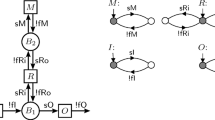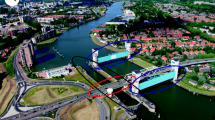Abstract
A typical gas transmission system consists of multiple components, which are controlled to keep the system safe. A controller designed based on simple “If–Then Rules” cannot be guaranteed to be controllable or non-blocking, unless by formal verification. Formal verification is a difficult procedure, specifically in a gas transmission system. In this paper, a systematic method is proposed to construct the modular discrete-event model and to synthesize modular supervisors in a gas transmission system, in order to maintain the safety in the system. Two supervisors are synthesized in this paper: (1) the surge-avoidance supervisor, (2) the allowable discharge pressure supervisor. Both of them are synthesized for each compressor station through one trunk line. The constructed modular supervisors are non-conflicting.












Similar content being viewed by others
References
Shahidehpour, M.; Fu, Y.; Wiedman, T.: Impact of natural gas infrastructure on electric power systems. Proc. IEEE 93(5), 1042–1056 (2005)
Judson, N.: Interdependence of the Electricity Generation System and the Natural Gas System and Implications for Energy Security. Lincoln Laboratory-MIT, New York (2013)
Li, Y.; Wang, Y.; Chase, J.G.; Mattila, J.; Myung, H.; Sawodny, O.: Survey and introduction to the focused section on mechatronics for sustainable and resilient civil infrastructure. IEEE/ASME Trans. Mechatron. 18(6), 1637–1646 (2013)
Folga, S.M.: Natural Gas Pipeline Technology Overview. Argonne National Laboratory, New York (2007)
Boyer, S.A.: SCADA: Supervisory Control and Data Acquisition, 4th edn. ISA, Pittsburgh (2010)
Manna, Z.; Pnueli, A.: Verifying hybrid systems. In: Hybrid Systems, Lecture Notes in Computer Science, Vol. 736, pp. 4–35. Springer (1993)
Nicollin, X.; Olivero, A.; Sifakis, J.; Yovine, S.: An approach to the description and analysis of hybrid systems. In: Hybrid Systems, Lecture Notes in Computer Science, Vol. 736, pp. 149–178. Springer (1993)
Koutsoukos, X.D.; Antsaklis, P.J.; Stiver, J.A.; Lemmon, M.D.: Supervisory control of hybrid systems. Proc. IEEE 88(7), 1026–1049 (2000)
Antsaklis, P.; Lemmon, M.: Introduction to the special issue on hybrid systems. Discrete Event Dyn. Syst. (Special Issue on Hybrid Control Systems) 8, 457–460 (1998)
Branicky, M.; Borkar, V.; Mitter, S.: A unified framework for hybrid control: Model and optimal control theory. IEEE Trans. Automat. Contr. 43(1), 31–45 (1998)
Heymann, M.; Lin, F.; Meyer, G.: Synthesis and viability of minimally interventive legal controllers for hybrid systems. Discrete Event Dyn. Syst. 8, 105–135 (1998)
Raisch, J.; O’Young, S.D.: Discrete approximation and supervisory control of continuous systems. IEEE Trans. Autom. Control 43(4), 569–573 (1998)
Afzalian, A.; Saadatpoor, A.; Wonham, W.M.: Systematic supervisory control solutions for under-load tap-changing transformers. Control Eng. Pract. 16(9), 1035–1054 (2008)
Noorbakhsh, M.; Afzalian, A.: Design and PLC based implementation of supervisory control for under-load tap-changing transformers. In: Proceedings of the ICCAS, Seoul, Korea, pp. 901–906 (2007)
Brandin, B.A.: The real-time supervisory control of an experimental manufacturing cell. IEEE Trans. Robot. Autom. 12(1), 1–14 (1996)
Theunissen, R.J.M.; Petreczky, M.; Schiffelers, R.R.H.; van Beek, D.A.; Rooda, J.E.: Application of supervisory control synthesis to a patient support table of a magnetic resonance imaging scanner. IEEE Trans. Autom. Sci. Eng. 11(1), 20–32 (2014)
Marques, D.; Morari, M.: On-line optimization of gas pipeline networks. Automatica 24(4), 455–469 (1988)
Uraikul, V.; Chan, C.W.; Tontiwachwuthikul, P.: Development of an expert system for optimizing natural gas pipeline operations. Expert Syst. Appl. 18, 271–282 (2000)
Gopalakrishnan, A.; Biegler, L.T.: Economic nonlinear model predictive control for periodic optimal operation of gas pipeline networks. Comput. Chem. Eng. 52, 90–99 (2013)
Bermúdez, J.R.; López-Estrada, F.R.; Besançon, G.; Valencia-Palomo, G.; Martínez-García, C.: Optimal control in a pipeline coupled to a pressure reducing valve for pressure management and leakage reduction. In: SysTol (2021)
Nejadkazemi, K.; Fakharian, A.: Pressure control in gas oil pipeline: a supervisory model predictive control approach. In: ICCIA (2016)
Nutaro, J.; Zeigler, B.P.; Jammalamadaka, R.; Akerkar, S.: Discrete event solution of gas dynamics within the EVS framework. In: ICCS (2003)
Saeidi, V.; Afzalian, A.; Gharavian, D.: Modular hierarchical supervisory control for surge avoidance in a gas compressor station. In: SGC (2015)
Wonham, W.M.: Supervisory control of discrete-event systems, Lecture Notes University of Toronto (2016). http://www.control.utoronto.ca/DES
Cassandras, C.G.; Lafortune, S.: Introduction to Discrete Event Systems, 2nd edn. Springer, New York (2008)
Yoon, S.Y.; Lin, Z.; Allaire, P.E.: Control of Surge in Centrifugal Compressors by Active Magnetic Bearings-Theory and Implementation. Springer, London (2013)
Gravdahl, J.T.; Egeland, O.: Compressor Surge and Rotating Stall-Modeling and Control. Springer, London (1999)
Botros, K.K.; Henderson, J.F.: Developments in centrifugal compressor surge control- a technology assessment. J. Turbomach. 116, 240–249 (1994)
Su, R.; Wonham, W.M.: Supervisor reduction for discrete-event systems. Discrete Event Dyn. Syst. 14, 31–53 (2004)
Khan, M.A.; Shamsuddoha, M.; Quraishy, S.A.I.: Pressure drop analysis of natural gas transmission line in Bangladesh. Int. J. Chem. Environ. Biol. Sci. (IJCEBS) 1(1), 196–200 (2013)
Uddin, N.; Gravdahl, J.T.: Bond graph modeling of centrifugal compressor system. In: 10th International Conference on Bond Graph Modeling and Simulation (ICBGM), pp. 177–184 (2012)
Blanchini, F.; Giannattasio, P.: Adaptive control of compressor surge instability. Automatica 38, 1373–1380 (2002)
Willems, F.; Heemels, W.P.M.H.; de Jager, B.; Stoorvogel, A.A.: Positive feedback stabilization of centrifugal compressor surge. Automatica 38, 311–318 (2002)
Shehata, R.S.; Abdullah, H.A.; Areed, F.F.G.: Variable structure surge control for constant speed centrifugal compressors. Control. Eng. Pract. 17, 815–833 (2009)
Burn, K.; Nored, M.G.: Application guideline for centrifugal compressor surge control systems. Release Version 4.3, GMRC-Southwest Research Institute, Dallas (2008)
Dresser-Rand Company.: Anti-Surge Control Manual (2005) (in Persian)
McMillan, G.K.: Centrifugal and Axial Compressor Control. Instrument Society of America, Pittsburgh (1983)
White, R.C.; Kurz, R.: Surge avoidance for compressor systems. In: Proceedings of the 35th Turbomachinery Symposium (2006)
Feng, L.; Wonham, W.M.: Supervisory control architecture for discrete-event systems. IEEE Trans. Autom. Control 53, 1449–1461 (2008)
Thistle, J.G.: Supervisory control of discrete event systems. Math. Comput. Model. 23, 25–53 (1996)
Wonham, W.M.: Control Design Software: TCT. Developed by Systems Control Group, University of Toronto, Canada (2014)
Author information
Authors and Affiliations
Corresponding author
Appendix
Appendix
In this appendix, a quick review of TCT commands is presented [41].
DES3 = supcon(DES1, DES2).
for a controlled generator DES1, forms a trim recognizer for the supremal controllable sublanguage of the marked (“legal”) language generated by DES2 to create DES3. This structure provides a proper supervisor for DES1.
DAT3 = condat(DES1, DES2) returns control data DAT3 for the supervisor DES2 of the controlled system DES1. If DES2 represents a controllable language (with respect to DES1), as when DES2 has been previously computed with supcon, then condat will display the events that are disabled at each state of DES2. In general, condat can be used to test whether a given language DES2 is controllable: just check that the disabled events tabled by condat are themselves controllable (have odd-numbered labels).
DES3 = supreduce(DES1, DES2, DAT2) is a reduced supervisor for plant DES1 which is control-equivalent to DES2, where DES2 and control data DAT2 were previously computed using supcon and condat. Also returned is an estimated lower bound slb for the state size of a strictly state-minimal reduced supervisor. DES3 is strictly minimal if its reported state size happens to equal the slb.
DES2 = project(DES1, NULL/IMAGE EVENTS) is a generator of the projected closed and marked languages of DES1, under the natural projection specified by the listed Null or Image events.
True/False = isomorph(DES1, DES2) tests whether DES1 and DES2 are identical up to renumbering of states; if so, their state correspondence is displayed.
Screen Display = show(DES).
DES2 = Allevents(DES1/DAT1/[EVENT_LIST]) is a marked one-state DES self-looped with all the events of DES1, or else the events listed in Condat file DAT1, or else the events entered directly by the user. DES2 is called the “allevents representation” of the associated event list. It can be used as specification for the supervisory control of DES1 with respect to the sole criterion of non-blocking.
SE displays an existing DES, SA a DAT (condat) table, and SX a TXT (text) file. Tables can be browsed with page keys. The file MAKEIT.TXT keeps a record of user files as they are generated.
Rights and permissions
Springer Nature or its licensor (e.g. a society or other partner) holds exclusive rights to this article under a publishing agreement with the author(s) or other rightsholder(s); author self-archiving of the accepted manuscript version of this article is solely governed by the terms of such publishing agreement and applicable law.
About this article
Cite this article
Saeidi, V., Afzalian, A.A. & Gharavian, D. Discrete-Event Modeling and Supervisory Control Synthesis to Maintain the Safety in a Gas Transmission System. Arab J Sci Eng 48, 7077–7092 (2023). https://doi.org/10.1007/s13369-022-07361-9
Received:
Accepted:
Published:
Issue Date:
DOI: https://doi.org/10.1007/s13369-022-07361-9




